Podcast: Play in new window | Download (Duration: 15:55 — 16.2MB)
Join us this week for some interesting crabs! Thanks to Charles for suggesting the aethra crab!
Aethra crabs look like little rocks, although some people (who must be REALLY hungry) think they look like potato chips:
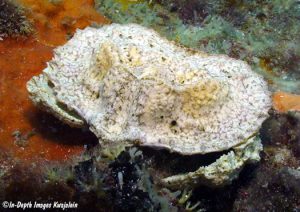
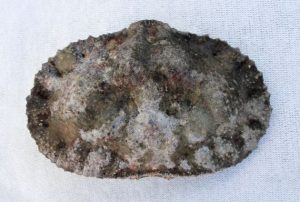
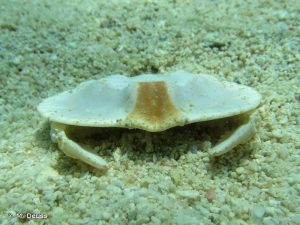
A hermit crab using a light bulb bottom as an inadequate shell:
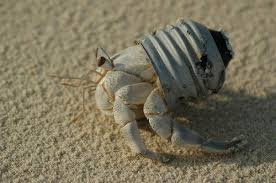
The tiniest hermit crab:

Gimme shell pls:
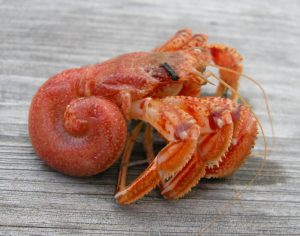
THE BIGGEST HERMIT CRAB, the coconut crab. It really is this big:
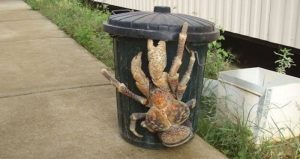
Show transcript:
Welcome to Strange Animals Podcast. I’m your host, Kate Shaw.
We have a bunch of crustaceans this week! I’m sorry I’ve taken so long to get to Charles’s suggestion of aethra crabs, so we’ll start with those.
There are four species of aethra crabs alive today, and they live in warm, shallow coastal waters. They like areas with lots of rocks on the sea floor, because the crabs look like small flattened rocks. They can tuck their legs under their carapace so that they don’t show at all, and often algae and other marine animals like barnacles will attach to the carapace, increasing the crab’s resemblance to a little rock. What eats rocks? Nothing eats rocks! So the aethra crab is safe as long as it stays put with its legs hidden. It lives throughout much of the world’s tropical oceans, especially around islands and reefs in South Asia, but also around Australia, Mexico, and Hawaii.
We don’t know a whole lot about aethra crabs, not even how many species there really are. There are probably undiscovered species that no one has studied yet, but we do know they used to be even more widespread than they are today. Twelve million years ago, for instance, a species of aethra crab lived in what is now Ukraine, with fossil remains only described in 2018.
Most aethra crabs only grow a few inches across, or maybe 6 cm, but the walking rock crab of Mexico can grow to 6.3 inches across, or 16 cm across. It’s light brown with lighter and darker speckles that give it a mottled appearance like a small rock.
Because they’re so flattened with rounded edges, and because some species are pale in color, aethra crabs are sometimes called potato chip crabs. I don’t like that name because it makes them sound tasty and not like little rocks. I think we have established that they really look like little rocks.
That’s just about all I can find out about the aethra crab, so if you’re thinking of going into biology and aren’t sure what subject to study, may I suggest you focus your attention on the aethra crab and bring knowledge about them to the world.
So let’s move on to a different type of crab, the hermit crab. A big part of being a crab is evolving ways to not be eaten. I mean, that’s what every animal wants but crabs have some novel ways of accomplishing it. Some crabs look like tiny rocks, some crabs hide in shells discarded by other animals.
There are hundreds of hermit crab species, which are generally grouped as marine hermit crabs and land hermit crabs. There’s also a single freshwater hermit crab that lives on a single island, Espiritu Santo, in the south Pacific, and in fact only in a single pool on that island. It was only described in 1990 and is small, less than an inch long, or about two and a half cm. It uses the discarded shells of a snail that also lives in its pool.
That’s the big thing about a hermit crab: it uses the shells of other animals as a temporary home. Like all crabs, the hermit crab is an invertebrate with an exoskeleton. But unlike most crabs, its abdomen isn’t armored. Instead it’s soft and vulnerable, but that’s okay because most of the time it’s protected by a shell that the crab wears. In most species the abdomen is actually curved in a spiral shape to better fit into most shells.
When a hermit crab finds an empty shell, it may quickly slip out of its current shell and into the new shell to see if it’s a good fit. Ideally the shell is big enough for the crab to hide in completely, but not so big that it’s awkward for the crab to carry around. If it likes the new shell it will abandon the old shell, but if it doesn’t like the new shell it will just go back to its old one. But the important thing is that it has a shell, so it spends as little time without a shell as possible. In fact, if it can’t find a shell of the right size, a hermit crab will make do with anything it can find, such as a plastic bottle, an old tin can, or other trash. But it’s safest inside a real shell. Sometimes two hermit crabs of about the same size will fight over a shell. You wouldn’t think that the ability of a hermit crab to find a good shell would be something humans can affect, but in some areas, so many shells are collected to sell as souvenirs that hermit crabs really don’t have very many left to choose from and have to use trash or pieces of driftwood instead.
Other than the freshwater hermit crab, marine hermit crabs all live in the ocean. Some species live in shallow water, others in deep water, and often around reefs. There are even a few species that are specialized to live in permanent structures on the sea floor, such as sponges or the abandoned burrows of various worms. Land hermit crabs spend most of their time on land, although they have to keep their gills wet.
People sometimes keep hermit crabs as pets, either in an aquarium for marine species, or a special terrarium for land species. Some species can live for decades if given proper care. Because a pet hermit crab is safe, it doesn’t really matter what kind of shell it wears as long as it’s comfortable, so people will sometimes give their pets imitation shells that are clear so they can see the crab’s interesting-shaped abdomen. You can also get fake shells that are shaped like skulls or tiny houses. There’s a picture that goes around sometimes online of a hermit crab using a real human skull as a shell, but that’s actually fake. Not only is the skull not real, the hermit crab isn’t real. It’s a sculpture.
The biggest species of hermit crab is the coconut crab, also sometimes called the robber crab since when it finds something that might be food, it will carry it away to investigate it. It’s not just the biggest hermit crab, it’s the biggest arthropod that lives on land. An arthropod is any invertebrate with an exoskeleton and segmented body. That includes all insects and crustaceans and arachnids, and so on.
The coconut crab has a legspan over three feet across, or about a meter. It can weigh up to nine pounds, or 4 kg. Researchers think it’s literally as big as an arthropod can grow these days and continue to live on land. It’s a bulky, strong crab that ranges in color from reddish-orange or brown to blue-gray, sometimes with white markings.
The coconut crab uses shells as protection when it’s young, but as it grows larger, it outgrows most shells available. Instead, it develops a tough exoskeleton on its abdomen. It also develops lungs, so an adult coconut crab can actually drown if it gets trapped underwater for long enough—generally about an hour. It still has gills, but they’re tiny and not very efficient.
Its lungs aren’t like those of most other arthropods. In fact it only has one lung, called a branchiostegal lung, that has traits of true lungs but also traits of gills. It doesn’t breathe like vertebrates do; instead, its lung absorbs oxygen from the air passively. To do this properly, though, the lung tissue needs to be moist. A coconut crab uses its hindmost pair of legs to dip water up and wipe it over the lung tissue, which is inside a cavity in the cephalothorax. This is the main part of the body as opposed to the abdomen. This last pair of legs is tiny compared to the other eight legs, and female coconut crabs also use these legs to tend their eggs. Usually the last pair of legs aren’t even visible, since the crab usually keeps them tucked in the lung cavity. The other legs are much larger, and the first pair of legs ends in claws like other crabs.
The coconut crab lives on lots of islands in the Indian and Pacific Oceans and used to live in Australia and on many more islands. But it’s a big crab and that means it provides a lot of food, so humans have hunted it to extinction in many areas. It’s increasingly rare in many places as a result of hunting and habitat loss. But the coconut crab isn’t helpless. If a coconut crab snaps its pincers on, for instance, a person’s thumb, it will hold on tenaciously, probably while the person flails around in panic and pain. Not only that, but sometimes a population of coconut crabs will feed on plants that contain toxins, such as the sea mango, and will retain the toxins in its body. If a person eats a toxic crab, they may get sick from the poison.
It’s called the coconut crab because it eats coconuts, but it actually doesn’t prefer coconuts. It especially likes bananas. It also eats seeds, nuts, and other plant material, but it’s an omnivore and will eat carrion, other crabs, baby turtles, and even birds. Its antennae have evolved to detect chemicals in the air instead of in the water, which means it has a good sense of smell and can track the smell of rotting fruit or meat from a long distance away.
Even the biggest crabs can climb well and will climb trees, sometimes to get away from potential predators, but sometimes to catch birds. The quickest way to get out of a tree after climbing it is just by falling, and the coconut crab often does this on purpose. Its exoskeleton is so tough that it can fall some 15 feet, or 4.5 meters, without injury. And yes, sometimes a coconut crab will use their claws to break into a coconut to eat it, but it takes a long time—sometimes days. The coconut crab is mostly nocturnal, but it will come out during the day if it’s hungry, especially if it’s raining or foggy out.
A female coconut crab glues her fertilized eggs under her abdomen and carries them around for a few months as they develop. When they’re ready to hatch, she releases them into the ocean. After they hatch, the larvae drift around for several weeks, eating tiny specks of food. As a baby coconut crab grows and develops through its juvenile stages, which generally takes several weeks, it finally settles to the sea floor and finds a shell to hide in, just like other hermit crabs do. If it can’t make it to shore on its own, it will climb onto a floating log or bunch of floating seaweed or a floating coconut, which eventually carries it to shore. It needs to be on shore because only the larvae can swim, and once it reaches its adult stage it has to breathe air.
Like other arthropods, the coconut crab has to molt its exoskeleton periodically as it grows, since the exoskeleton can’t grow. After it molts, it takes up to three weeks for the new exoskeleton to harden. During this time the crab hides in a burrow it digs, because even a gigantic coconut crab is soft and vulnerable without its exoskeleton. It lines its burrow with coconut fibers, which absorb water and helps keep the crab’s lung tissue moist while it rests. The crab will also stop up the entrance to its burrow with one of its claws, to help keep it safe and reduce the loss of moisture from the burrow. The coconut crab continues to grow throughout its life, which can be extremely long—more than sixty years. A big coconut crab’s only predator is people, and frankly I would not want to tangle with one.
Let’s finish the episode with a mystery crab. Wallowa Lake in Oregon, in the United States, is about three and a half miles long, or 5.6 km, and three-quarters of a mile across, or 1.2 km, and is 300 feet at its deepest point, or 91 meters. After gold was found in the area in the late 19th century, the Wallowa band of the Nez Perce was forced out of their ancestral home by the U.S. government, despite the treaties in place to stop that kind of thing happening. Funny how often that happens. Anyway, the gold rushers who moved in spread stories about giant crabs that lived in the lake, which would crawl out at night to grab cattle and pull them into the water to eat.
But the lake was created from melting glaciers near the end of the Pleistocene ice ages, around 11,000 years ago. It’s never been connected to the ocean and is in fact 4,300 feet above sea level, or 1,300 m. It’s also in a part of the world that experiences bitterly cold winters. All freshwater crabs are tropical or subtropical and can’t survive in cold water. Plus, of course, even the biggest coconut crab isn’t big enough to drag a cow into the water.
So the Wallowa Lake crabs are probably just tall tales. But, you know, maybe be careful if you go swimming in the lake at night, just in case.
You can find Strange Animals Podcast online at strangeanimalspodcast.blubrry.net. That’s blueberry without any E’s. If you have questions, comments, or suggestions for future episodes, email us at strangeanimalspodcast@gmail.com. If you like the podcast and want to help us out, leave a rating and review on Apple Podcasts or wherever you listen to podcasts. We also have a Patreon at patreon.com/strangeanimalspodcast if you’d like to support us that way.
Thanks for listening!